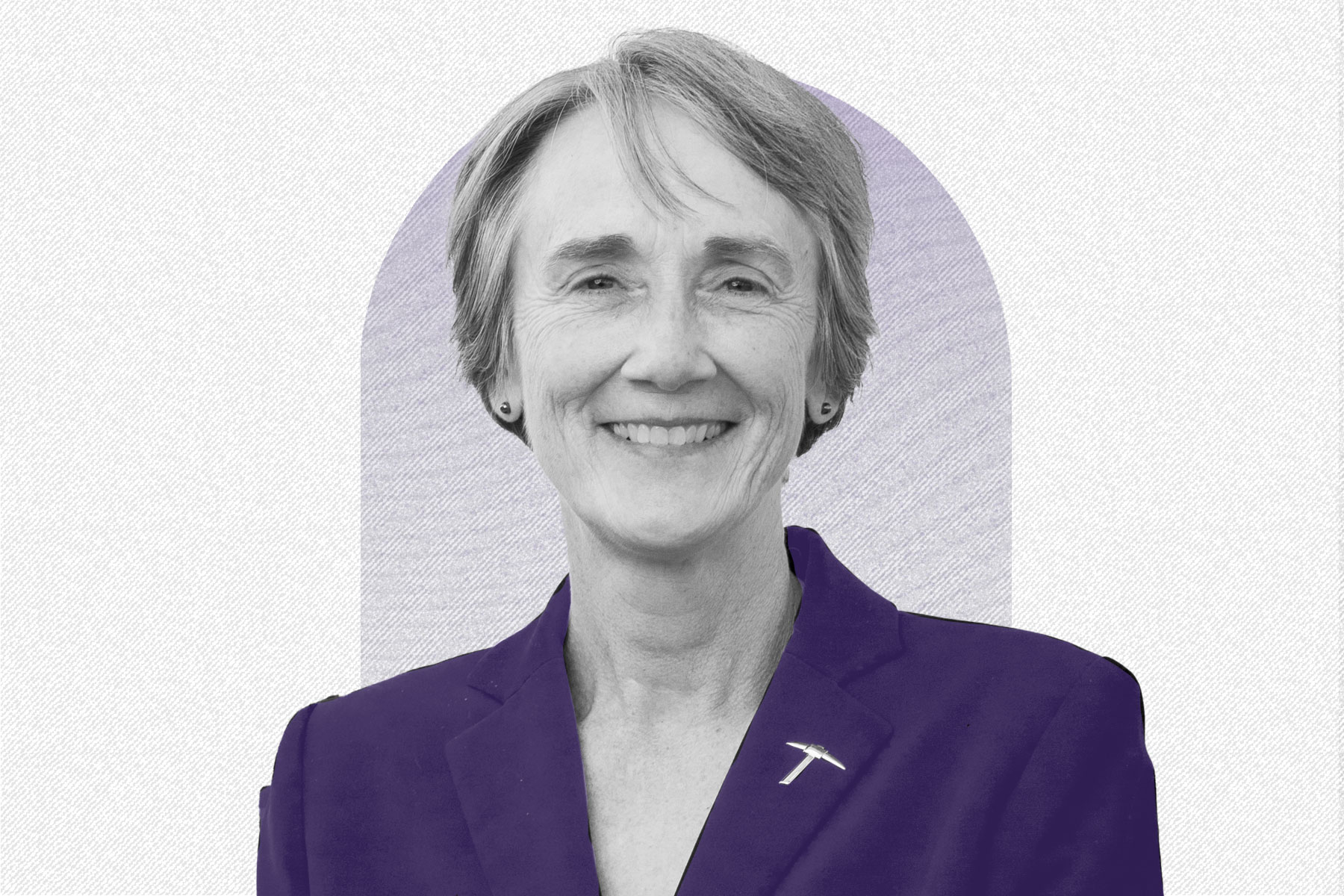This Hispanic Heritage Month, we’re telling the untold stories of women, women of color and LGBTQ+ people. Subscribe to our daily newsletter.
“We offer an engaged education that is excellent, accessible and more affordable than many other universities.”
In a nutshell, that’s how Heather Wilson, the president of the University of Texas at El Paso (UTEP), describes the appeal of one of the nation’s leading Hispanic-serving institutions (HSIs). Eighty-four percent of UTEP’s 24,000 students are Hispanic, more than triple the percentage (25 percent) the federal government uses to designate a college an HSI.
Unlike historically Black colleges and universities (HBCUs), which first provided higher education to Black students when schools were largely segregated, HSIs are categorized as such because they enroll large numbers of Hispanic students. Located in a corner of West Texas that borders New Mexico and Mexico, UTEP includes both Hispanic Americans and Mexican nationals and has undertaken a number of efforts to ensure those students succeed. In 2019, it became one of the first institutions to earn a certification from Excelencia in Education, a national organization that advances higher education for Hispanic students. Last year, Wilson was elected the first chair of the Alliance of Hispanic Serving Research Universities, an organization made up of schools that are both HSIs and in the top 5 percent of national research universities.
UTEP has also worked to make education more affordable for its students — more than half of whom are first-generation college students — as student debt nationally has spiked to more than $1.7 trillion. The average first-year UTEP student eligible for grants and scholarships pays only $800 in tuition and fees annually.
“Our students know a good value when they see one,” said Wilson, who became UTEP’s 11th president in 2019 after serving as secretary of the United States Air Force. She also represented New Mexico in Congress for a decade and graduated from the U.S. Air Force Academy as part of the third class to admit women.
The 19th interviewed Wilson about UTEP’s success as an HSI, lowering college costs for students, the possible effects of anti-DEI legislation in Texas and her leadership style as one of the small percentage of women presiding over a top research university.
This interview has been edited for length and clarity.
Nadra Nittle: College enrollment took a dive during the pandemic — a trend that is now slowly reversing. How did UTEP manage to achieve record-high graduating classes over this period?
Heather Wilson: We have worked hard to address the issues that might keep our current students from persisting to graduation. We’ve recently expanded and revamped our student advising team to help connect students with the resources they need to succeed. Of course, when students persist instead of dropping out, that helps our enrollment numbers as well.
We’ve also invested in doing deeper recruiting in our region, as well as recruiting from other parts of Texas, Arizona, New Mexico, California and northern Mexico, so we’re seeing those efforts start to pay off.
-
Read Next:
UTEP has received honors such as the Seal of Excelencia, which recognizes institutions that have intentionally undertaken efforts to accelerate Latino student success. It has also been ranked No. 1 in Texas for social mobility because it puts low-income students on track to obtain high-paying jobs. How has UTEP achieved these outcomes?
There is an ongoing nationwide conversation about how traditional metrics of university success leave out important rationales for higher education, like social mobility. The Seal of Excelencia is one of the early measures that focused on student success and what it means to truly serve students. From the UTEP perspective, it’s important not to conflate exclusivity with excellence and instead focus on student experience, persistence to graduation and long-term outcomes after they walk across the graduation stage.
A large part of our success comes from offering students extra support and resources, like a strong advising model, peer mentoring, financial support and undergraduate research experiences that give them a reason to persist and an advantage after graduation.
We have strong partnerships with leading employers around the globe, so we excel at connecting students to internships and eventually great jobs. In the past few years, we’ve announced new partnerships with the United States Space Force, several Department of Energy national labs (Sandia, Los Alamos, Pacific Northwest), leading U.S. banks (Bank of America, Chase), HCA Healthcare, to name a few. Of course, we have strong ties with many regional companies on both sides of the border, and we leverage those to benefit our students.
As concerns about student loan debt mount, especially for students of color, UTEP has worked to reduce the cost of college. You recently announced that tuition won’t be raised for the next two years, and, through the Paydirt Promise program, UTEP covers full tuition and mandatory fees for four years for families with incomes under $75,000. How is UTEP able to provide this kind of help?
We find that finances are the No. 1 hardship keeping students from enrolling in college and, for those who do enroll, staying in college. So making UTEP affordable is a very high priority for us. We’re able to help so many of our students with significant financial aid because of our diversity of support from alumni, philanthropic foundations, the Texas state legislature and the UT System regents.
Philanthropy is a huge part of meeting student needs, and we are grateful for our hundreds of major partners who give to support student scholarships. One new partner is the Lopez Foundation, which supports dozens of UTEP students with full-ride scholarships. The work of our advancement team in connecting donors with opportunities to help students has been outstanding. We’ve seen record fundraising support for the last three years in a row.
The state of Texas legislature and the taxpayers have also been very generous to UTEP, both in increasing support of our general operations and by providing resources for buildings, research and scholarships. This has allowed us to resist raising tuition even in inflationary times and still continue to build on educational excellence.
Finally, we are blessed to have strong support from the UT System and our Board of Regents. For several years, we’ve had a last-dollar promise scholarship program [to allow low-income students to attend college without taking on significant debt] with limited reach, but additional funding from the Board of Regents this year has allowed us to help even more students with financial need through the Paydirt Promise Plus program. I appreciate the leadership of Regent Chairman Kevin Eltife and UT System Chancellor James Milliken in providing resources to close the need gap when Pell and Texas Grants just aren’t enough.
UTEP serves students on both sides of the border. Can you discuss your partnership with Chihuahuan universities and efforts to make college more accessible for Mexican nationals? Why is it important to serve students throughout the binational region?
UTEP is located less than a mile from the U.S.-Mexico border. Around 1,200 UTEP students commute daily from Juárez, and we have many other students who have moved to El Paso from other parts of Chihuahua and Mexico.
El Paso has been a border and trading community for over 400 years. People are constantly moving back and forth across the border, living and working on both sides, seeking health care and other services on both sides, etc. Our economies are intertwined. Offering a great education to students in Juárez is a way of lifting the whole region.
A few examples of what we’ve done to expand this relationship: We have scholarships and in-state tuition [for] students from Mexico. Our faculty have joint research partnerships with Mexican universities. And we recently signed an agreement with the state of Chihuahua so that UTEP graduates can have their degrees officially recognized by the state in order to obtain their professional licenses in Mexico.
I’ll also note that we received a major gift from the Hunt Family Foundation last year to transform the Hunt College of Business into the leading institute for the study of U.S.-Mexico trade and commerce. Mexico is America’s largest trading partner, and fully 20 percent of that trade comes through El Paso.
Last year, you were elected inaugural chair of the Alliance of Hispanic Serving Research Universities. Can you discuss what you hope to accomplish in this role and why this alliance is important?
All of the members of the HSRU Alliance have been working individually towards increasing the number of Hispanic faculty and Ph.D. students, but there are some things that we can do better together than separately, and that is why we formed the Alliance.
To achieve our goals, we are developing partnerships with research-funding entities, including non-profit foundations and federal sponsors, to change the professoriate and expand the number of Hispanic students choosing to pursue advanced education.
A new law in Texas that takes effect in January will ban DEI (diversity, equity and inclusion) in the state’s public colleges and universities. How will this affect UTEP’s work to achieve Latino student success and recruit diverse faculty?
SB17 will have no practical impact on UTEP. Making people from all backgrounds feel welcome is the job of everyone at UTEP, not the job of one person or one office. Our approach to inclusive excellence and our culture of care is strong and will continue to be so. Our mission to increase access to excellent higher education remains unchanged.
UTEP has had tremendous success both in enrolling Hispanic students and graduating them, but some have pointed out that, at UTEP and nationally, there’s a gender divide among Hispanic students, with young women more likely to graduate than men. How is UTEP addressing this gender divide?
Women are pursuing higher education at higher levels than men across the country, and nationally, the graduation rate for women from college is about seven points higher than men, so this phenomenon is not unique to UTEP, nor is it unique to Hispanics. There are a lot of different cultural forces at play here, and likely not one silver bullet solution will close the gender gap.
I’ve seen some recent research that shows this gap starts well before college, with girls earning higher GPAs and taking more college prep courses, generally making them more prepared for college.
UTEP provides resources for students who may not think they are ready for the rigors of college classes. Our approach is to meet students where they are and, if they are willing to work hard, ensure they have the tools to succeed. We certainly want young Hispanic men today to know that college is for them, and they are welcome at UTEP.
You’re not Hispanic yourself, but you have noted that your grandparents were immigrants and that you were the first person in your family to go to college, experiences to which many UTEP students can relate. Can you discuss those aspects of your life and anything else you feel connects you to UTEP students?
A large percentage of our faculty and staff can identify with our first-generation college students, and I include myself in that group. College can be challenging for everybody, but especially for first-generation students who don’t have the “social capital” that other students might have been born into.
I also know how important education will be for our students and how much it will change their lives and the lives of their family members for the better because I have lived that experience. I enjoy engaging with our students and helping to encourage them and show them the way.
We also recognize the strengths that our majority Hispanic, binational student body brings to the table that are unique. Many of them are fluently bilingual, savvy at navigating life in two countries and have an admirable work ethic and strong family support network that will serve them well. We try to build on these strengths.
You’re UTEP’s second woman president, succeeding the late president Diana Natalicio. What do you think needs to change to ensure that other women become higher ed leaders? How do you think your leadership style stands out, be it because you’re a woman, because of your experience in Congress, in the U.S. Air Force Academy, or in any other capacity?
I tend to be a values-driven, mission-focused and people-oriented leader. Like a lot of experienced leaders, I know that the mission is more important and will outlive all of us currently serving here. That said, I do have high expectations of myself and others and the discipline to get things done while keeping the long term in mind. Throughout my life, I have often found that the word “leadership” is spelled w-o-r-k. If you’re willing to work hard, opportunities to lead and contribute seem to be plentiful.
As to how we get more women in top leadership positions, I think women are strong leaders. We need to encourage women in administration and faculty to be willing to put themselves forward for positions of responsibility. And those of us in positions of leadership need to make sure that there are seats at the table for all the talent around us.








